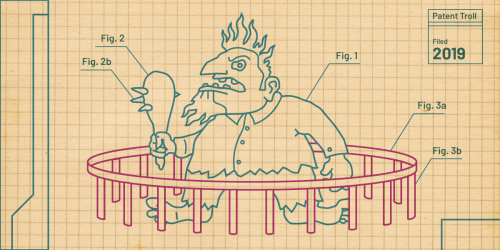Finding people near you with shared interests, and talking to them, has a very long history in human culture. We’re social animals. We need to find other people close to us to work together with, play games with, and build relationships and families with. Modern online social networks are built on top of those basic human needs.
The technologies we humans use to do these things are ever-changing, but the basic concepts aren’t. Software that promotes new types of social networking is a terrible fit for the patent system, which hands out hundreds of thousands of 20-year monopolies each year on inventions that are supposedly new, but often aren’t. No one should be able to patent an “invention” that simply describes a method of finding like-minded people.
Unfortunately, that seems to be just what happened with a patent we looked at recently. A patent troll called Wireless Discovery LLC sued eight different social and dating apps for patent infringement, claiming that they infringe U.S. Patent No. 9,264,875, which claims “location-based discovery” based on people’s “personal attributes.” Wireless Discovery, which was created just before its patent was granted in 2016, sued eight different online dating apps in April—most of them small apps.
Claiming the “Mobile Social” World
Wireless Discovery lawyers say that a simple combination of basic computing services is enough to infringe their patent. Its claim chart makes it explicit what is required to infringe the ‘875 patent. For its lawsuit against the dating network Zoosk, the claim chart describes how:
- Zoosk has a website that mobile devices can connect to.
- Zoosk’s server collects information from the mobile devices, including location and unique device identifiers.
- Zoosk users can send and accept invitations to connect with and send messages to each other.
- Zoosk shares profile information of connected users, who are “members of a same social network” (i.e., they’re on Zoosk)
- Zoosk can connect users who are in the immediate vicinity of each other, or a particular distance away.
And that’s it.
The Wireless Discovery patents were originally filed for a company called Ximoxi, which tried to market a type of “electronic social cards.” Ximoxi founder Ramzi Alharayeri, who is the named inventor on the patent, said in a 2012 press release that his software was “the first social-discoverability application that works on iPhone, Android and Blackberry alike.”
In 2016, however, the Ximoxi website said that the app was still “under development.” It continued: “After releasing our Beta, we needed to go back to work for bugs fixes and features improvements.” Today, the Ximoxi website is defunct.
Not the First
The idea of connecting nearby users of a social network isn’t an idea that should be patentable at all. But it’s also worth noting that—even if Ximoxi executed this concept in some way—it was far from the first. The Ximoxi patent was filed in 2014, but claims that it’s a continuation of a patent that was originally filed in October 2008, the time that Ximoxi was founded.
Location-based social networking on mobile devices is quite a bit older than that, though. It was conceptualized, and used, well before smartphones were common. The New York City-based app “Dodgeball” dates back to 2000. It was acquired by Google (with plenty of press coverage) in 2005. By then, it was clear that different types of social mobile apps were going to be taking off. A paper presented at the 2006 IEEE engineering conference notes the growth of mobile social networking: “An entire sub-industry of the wireless sector is slowly being created as companies such as Dodgeball, Playtxt, and SmallPlanet.net begin to capitalize on this new phase in the mobile technology platform.”
None of this earlier technology was presented to the U.S. Patent and Trademark Office in Wireless Technology’s patent applications.
Unfortunately, this is all too common. It’s how many software patents get issued—examiners have just 18 hours, on average, to complete the examination, and the applicants can come back with endless revisions. Ultimately, persistent applicants get patents, even when they don’t have a great case for one.
And those monopolies do serious damage. Most patent lawsuits filed in the past several years aren’t disputes that result from a company trying to defend the market for its product. Rather, they are initiated by patent trolls—companies with no products, that simply use patents to demand payment from others. In 2021, 87 percent of high-tech patent disputes in federal courts were filed by companies or people that make most of their money from patent licensing.
It’s very difficult, and expensive, to get patents thrown out in court, even when the technology described in the patent existed long before the patent was filed. That’s why 10 years ago, Congress created a more robust review system for already-granted patents, called inter partes review (or IPR). Over the years various patent owners have tried to weaken the IPR system, encouraging the patent office to reject many IPRs on technicalities, or even saying IPRs are unconstitutional. Thankfully, those efforts have all failed.
There’s a bill in Congress that would strengthen IPR, closing some of the loopholes that patent owners have used over the years to dodge the IPR process. Right now, passing the Restoring America Invents Act, as it was introduced, is the best thing we could do to weed bad patents out of the system.
Related documents:
- Wireless Discovery LLC v. Zoosk Complaint
- Wireless Discovery LLC v. Zoosk Claim Chart
- Wireless Discovery LLC v. Coffee Meets Bagel Complaint








